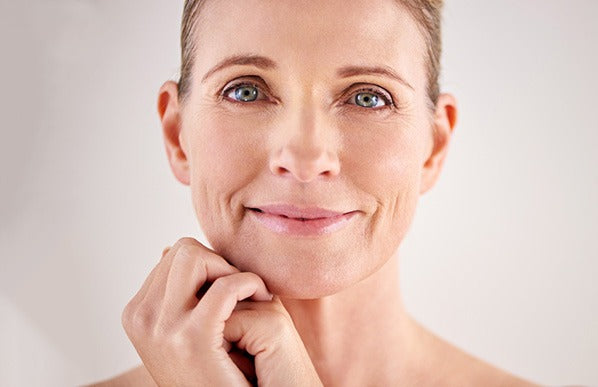
Best Solutions for Congested Skin (aka Neglected Skin)
What are the best solutions for congested skin? Bottom line: a natural approach will get you the deep cleansing you need without stripping your face of the essential oils it needs. A word to the wise: no single product can do it all. So start by researching a number of product lines, their various formulas, and the unique contributions each can make to a healthy complexion. As you gather information, keep these basic guidelines in mind.
Start with Careful Cleansing
Of course, proper cleansing is the foundation of a good complexion. But it can be hard to stick with a daily (or twice daily) skincare routine. Get lazy for too long and you'll start to see that your face looks "congested." Your pores are enlarged and tiny bumps or blackheads are starting to show, especially on your chin, nose, and forehead. Maybe you're seeing some puss-filed whiteheads, too.
A lot of people assume that the problem is grease lodged deep inside their pores, and they try to get rid of it with harsh cleansers or exfoliating scrubs. That's a mistake. The real cause of the problem is dead skin cells that have accumulated under the surface of your skin. Best to use products that will gently eliminate that buildup.
Choose a relatively natural soap that can eliminate dirt without depleting moisture. Always wash with warm water, never hot. And refuse to scrub vigorously because that will only irritate the skin and cause more breakout.
Cleansers with vitamin C are absolutely the best, but be aware that many vitamin C formulas become inactive within a matter of weeks. So look for cleansers that contain "ascorbic acid," a natural form of vitamin C that stays fresh and effective for many months.
Cleansing Is Only the Beginning. Keep Going!
In order to look its best, your face needs attention beyond cleaning. For example, it needs protection from environmental contaminants. It also needs nourishment – vitamins, minerals, herbs and antioxidants – to keep it healthy and hydrated.
While there are hundreds of products out there to help you complete a basic skincare regimen, they basically fall into 3 categories. Based on your skin type, age, and lifestyle, some will help more than others. So let’s look at what’s available and how to choose wisely.
Tip 1: Use a Toner as the Final Step in Cleansing
Facial soaps work by opening your pores and removing superficial dirt. In the process, all but the very finest strip away natural oils and moisture. That’s especially bad if you have dry skin, or if you’re dealing with mature skin.
Just as important, by opening your pores, a soap or facial scrub exposes deeper layers of facial tissue to airborne contaminants. A toner’s job is to close the pores back up, so your skin is protected from that damage. Plus, a good toner temporarily tightens pores – creating the look of a smoother complexion.
Most reputable cosmetic lines offer a toner. But if you're looking for something fairly affordable, try rose water. Many estheticians recommend it, and it's easy to find in the cosmetic section of better health food stores.
Tip 2: Moisturizers Are Protective Armor for Your Skin
Facial moisturizers are probably the most popular follow-up to cleansing. A good moisturizer will hydrate your skin and feed it healthy oils (sometimes called lipids) that work like a layer of protection for your skin, conditioning it and locking in healthy moisture.
Remember, always cleanse before using a moisturizer. And don’t dry your face completely after washing. Instead, pat lightly with a clean towel and immediately apply the moisturizer. Your skin is still porous at this time, so it can more fully absorb the product.
Something most people don’t know: a moisturizer should always be applied at night, before bed. Only if you have very dry (or aging) skin should you re-apply after cleansing in the morning.
Tip 3: Only a Serum Can Offer Ultra-Active Penetration
The biggest difference between a serum and a moisturizer is what the serum does NOT contain. Basically, it has no greasy ingredients (like petroleum or mineral oil).
So you’re left with just a high concentration of active ingredients. Antioxidants to revive damaged or aging skin. Peptides to stimulate collagen production. And skin brighteners to fade age spots, acne scars, and hyperpigmentation.
Serums are usually the costliest product in any skincare line, but a good one is so powerful that it will take only a little to achieve the desired result. Made of very small molecules, serums are quickly absorbed. So the results are almost immediate.
Men often like serums because the formulations are completely non-greasy. That means they don’t leave behind any stickiness, creaminess, or dewy sheen. This is also good for adolescent and acne-prone skin that typically has an over-abundance of oil already.
When you apply serum, pat it lightly onto your face, immediately after cleansing, morning and night. Use just a pea-size amount for each application.
Then, if your skin is dry or mature, follow up with a moisturizer. But always apply the serum first. Then wait 15 minutes (so it can fully penetrate your skin) before adding the moisturizer.
The Bottom Line
If you can afford it, and are willing to take the time…
- Use all four skincare products daily, in this order: Cleanser, Toner, Serum and Moisturizer.
- To save money and time, you can probably skip the toner because a good facial cleanser will compensate for its benefits.
- If you want to whittle down your routine even more, eliminate the moisturizer. Especially if you have a trouble-free complexion, an active-ingredient serum will do more to nourish your skin and the benefits will show faster.
- However, if your skin is very dry, or has begun to show visible signs of aging, you’d be smart to use both a good-quality moisturizer and serum.
Good luck, good looking!
